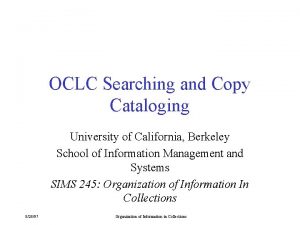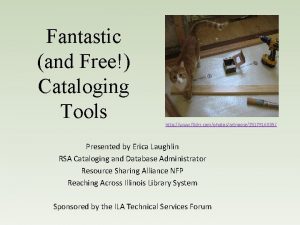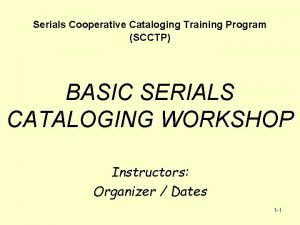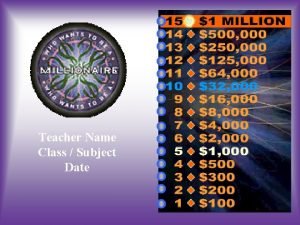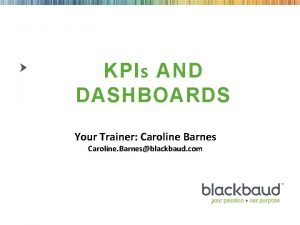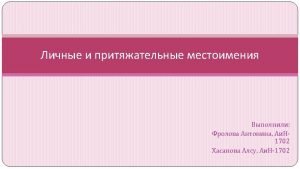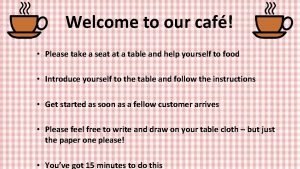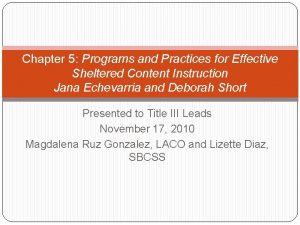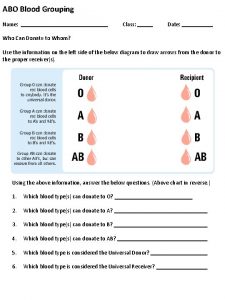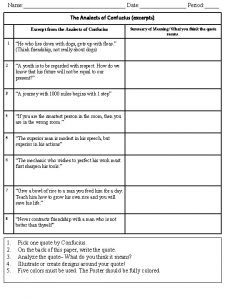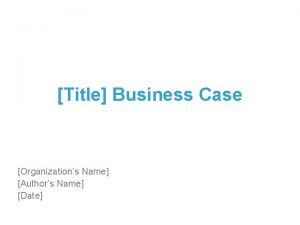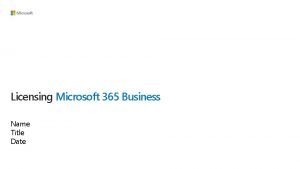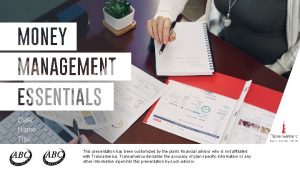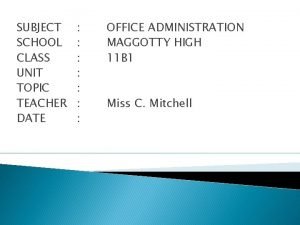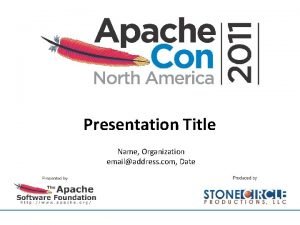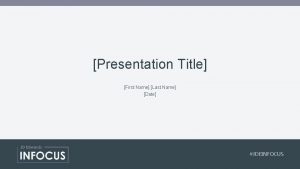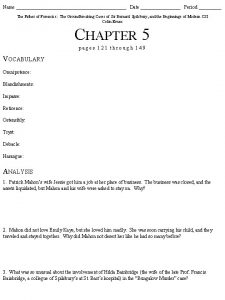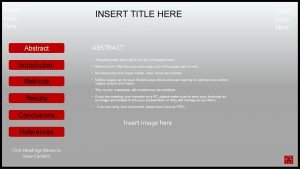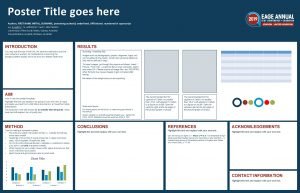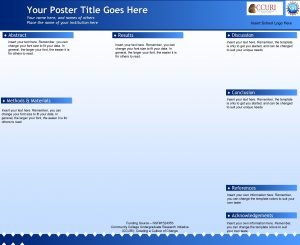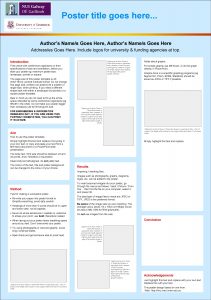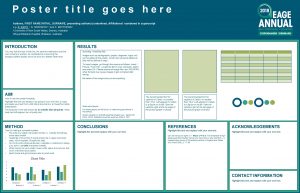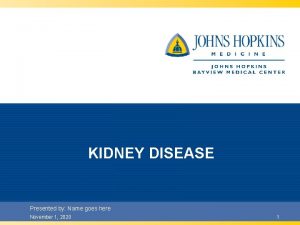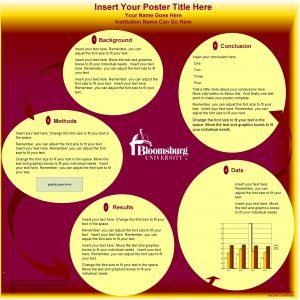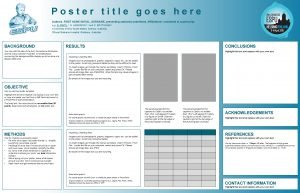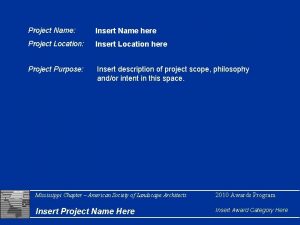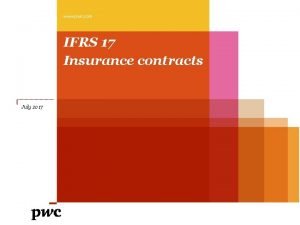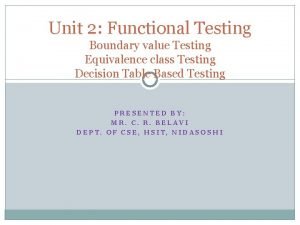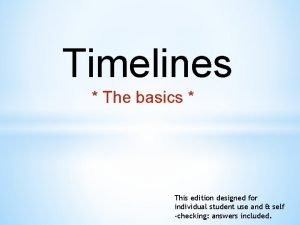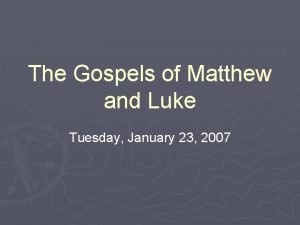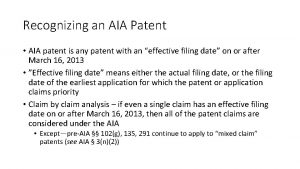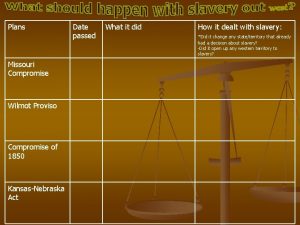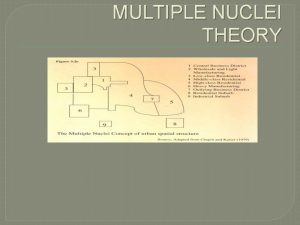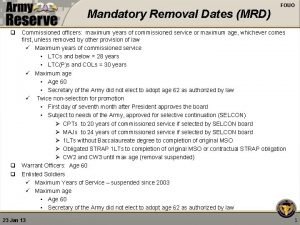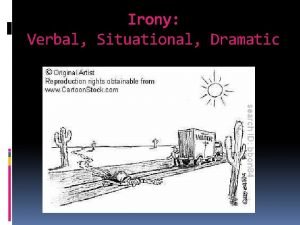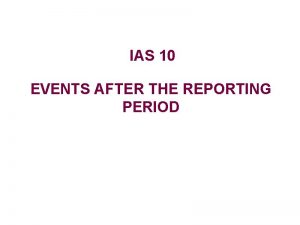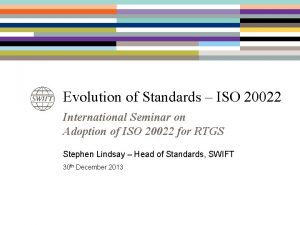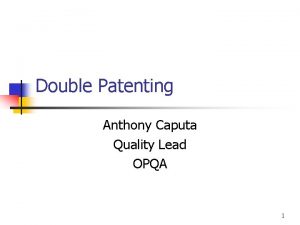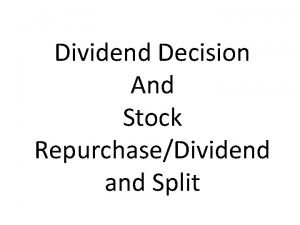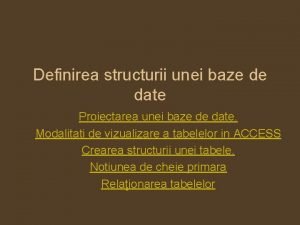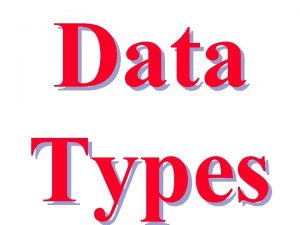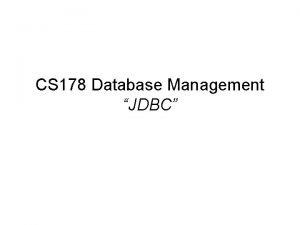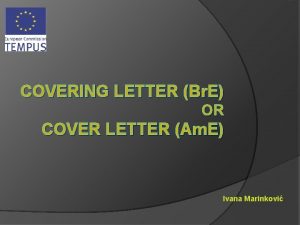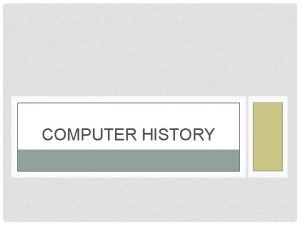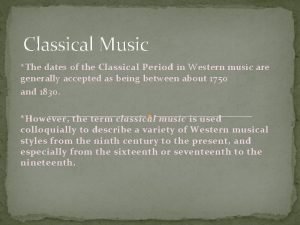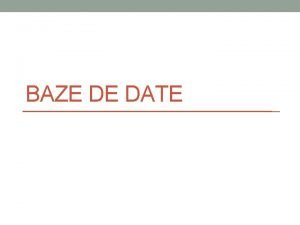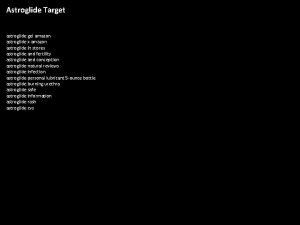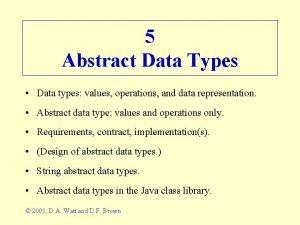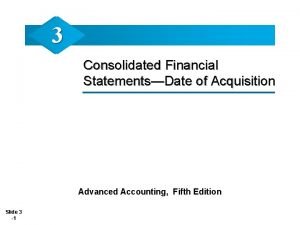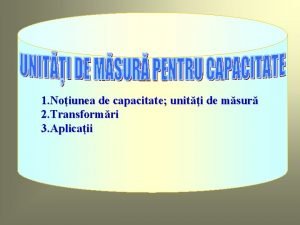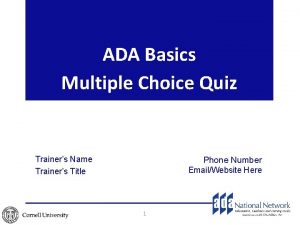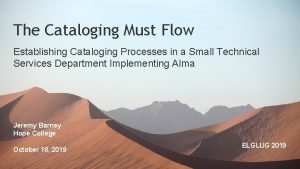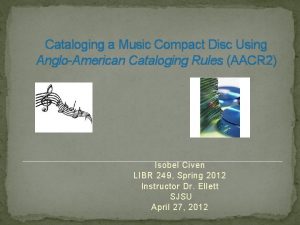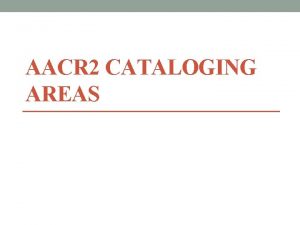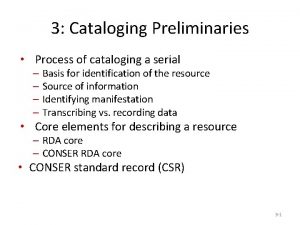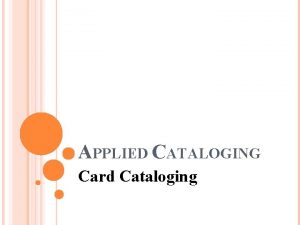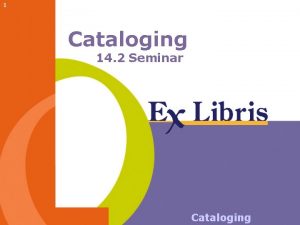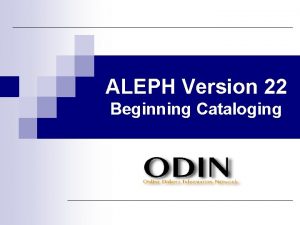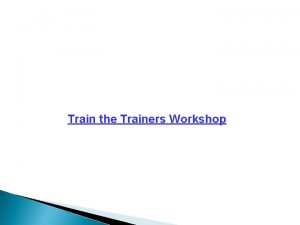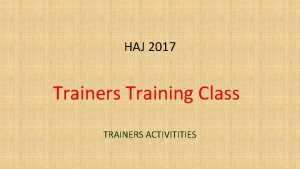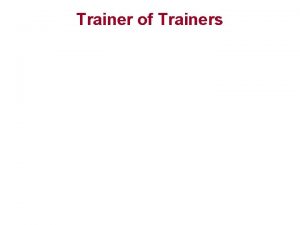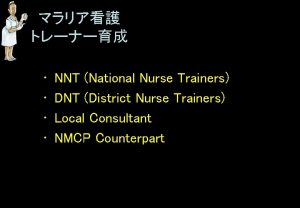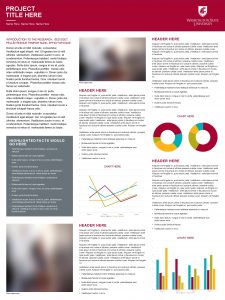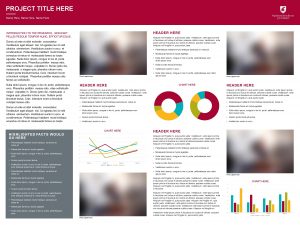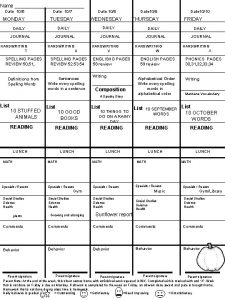Cataloging University Name here DATE HERE Trainers NAME




































































































































- Slides: 132

Cataloging University Name here DATE HERE Trainer’s NAME HERE

Session Agenda Stage Stage Stage Stage 0: Introduction 1: Accessing Records 2: Creating Records 3: Saving Records 4: Check Routines 5: Editing Records 6: Search Headings 7: Locate Similar Records 8: Fix Routines 9: Authority Control Summary 10: Other Cataloging Functions 11: Importing Records 12: Authorizations and Privileges Note: all examples are based on MARC 21. 2 Cataloging

Stage 0: Introduction 3 Cataloging

Opening the Cataloging Module In the Catalog module, you may choose one of three modes: System number Record mode Items mode Search mode Barcode From the first window, you may access • a specific record by system number, or • a specific item by barcode or call number. 4 Cataloging

The Record Mode Upper Pane – Catalog Editor Navigation Pane Lower Pane – Tag Information Note: a red frame will enclose the pane in focus Cataloging 5

The Items Mode Upper Pane – Item List Navigation Pane Lower Pane – Item Update 6 Cataloging

The Search Mode Upper Pane – Brief List Search/ Show Pane Lower Pane – Full View 7 Cataloging

The Operations Bar (Bottom Tray) Left-hand part: showing server communication. When the client communicates with the server, a red ‘stream’ is displayed. Push to other modules: Acquisitions, Circulation, ILL and Alephadm Right-hand part (right-click) Login, • password changing and privileges • Menu language setup • Connect to a different library • Printing options • Exit all ALEPH applications 8 Cataloging

The Top Bar (Right) • Open template • Overview tree in upper pane (y/n) • Split editor mode (y/n) • Save on server and local drive • Check record • Activate ALEPH keyboard (y/n) • View in Search mode • ‘Push’ to Acquisitions • Close current record / all records • View record in full screen mode 9 Cataloging

Select Library Although you may work with records from several libraries at the same time, you must be connected to a base library. Menu/ALEPH/Connect to… New records will be cataloged into this library. 10 Cataloging

Select Collection You may also connect by right-clicking the Collection icon on the Operations Bar in the bottom tray. Look at the Title (top) Bar to view the library (and server) you are currently connected to. 11 Cataloging

Importing Tables When you connect to the required library, the system checks to make sure that the Cataloging Module is using the most recent version of the cataloging and print files. If these have been modified, they will be downloaded into the pc (Depending on setup). That explains the ‘Transfer File’ window that appears briefly upon initial connection. 12 Cataloging

Stage 1: Accessing Records 13 Cataloging

Accessing Records There are two main ways to access records in the Cataloging module: • Finding a record – by Find (keyword search) or – by Browse • Direct access – Locally-saved records – Records saved on the server 14 Cataloging

Browse for a Record The Browse function enables you to scroll through an alphabetical index and retrieve the records attached to the desired entry from the list. Select the Search Base, then the Index (or Headings List) you wish to browse, enter the initial characters of your search string, and click ‘Go’. 15 Cataloging

Browse for a Record An example: browsing for “librar” in the Titles index. Note that the result list always shows one heading which is just above the requested one in the headings list. 16 Cataloging

Find - Keyword Searching The Find function enables you to retrieve records using keywords. Searching will be performed in the selected Word Index (such as Words in Title, Words in Author, etc. ), or in a combined index, for records which contain the keyword/s. 17 Cataloging

Find - Keyword Searching 1. 2. 3. 4. Select the search base. Check the ‘Words Adjacent’ box if the search query should be treated as a string. Select a search index. Enter the keyword/s and click OK. • You may use wildcards (e. g. comput* ). • Multi-index searching is possible using the two additional search boxes. 18 Cataloging

Results List The Results List showing the number of matched results will be displayed in the lower pane. If the number of results is lower than a pre-defined number, a Brief List will be displayed instead (more below). 19 Cataloging

Results List Options Print/Send to print, email or save results locally in one of the offered formats. Save on Server Save the result set on the server under a chosen name. Load Download a previously saved set. Show Display records as a Brief List and Full View. 20 Cataloging

Brief List Click the Show option to see the Brief List of records (upper pane), with the full record view (lower pane). 21 Cataloging

Brief List Options Sort records by two sort types. Save As Select records from the list and save as a new set. My Records Save a list of your search hits for use later. Records are saved in XML format on the local drive. Click ‘Load’ to open previously-saved records. 22 Cataloging

Full View of Record The lower pane shows a Full View of the record which was selected on the Brief List. 23 Cataloging

Full View Options Note: Which buttons are active depends on which field is selected on the full view. Locate records which are similar to the current one (More below). Show Like (depending on selected field) Show records which have the same data as in the selected field. Headings (depending on selected field) Display the Browse List, with the line chosen for the type of list and the starting text. 24 Cataloging

Full View Options External For fields pointing to external resources (e. g. 856), open up the relevant resource in a browser. Link To display records which are linked to the current one in a parallel, up or down relationship. Item List When a Holdings or Item field is highlighted, view the items linked to this record (all items, or items from a specific sublibrary, respectively). Catalog Change the display to the Catalog mode. Items Change the display to the Items mode. 25 Cataloging

Opening Records may have been saved on the local drive, or on the server. Locally-saved records may have been cataloged by a junior cataloger, and await approval by a more senior one, who has the authority to save them on the server. Note that a locally-saved record may only be seen by the cataloger using that particular pc. 26 Cataloging

Opening a Locally-Saved Record To open a locally-saved record, click Menu/cataloging/Open Record on Local Drive. 27 Cataloging

Load Record From Server To open a record saved on the server, enter its system number in the top left field, and click the ‘arrow’ icon. Alternatively, enter an item barcode in the second field (or browse the Item List by call numbers). System no. search Item call number or barcode search Browse call numbers 28 Cataloging

My Records You may keep hits from your searches in My Records will be saved locally, as an XML file. A note may be added to saved records, for retrieval later on. View, print or send the saved records from the My Records tab. You can also move a record to the Catalog mode for editing. 29 Cataloging

Stage 2: Creating Records 30 Cataloging

Creating Records can be created from scratch, or based on pre-defined templates. Alternatively, records may be imported from other sources (more later). With each of these options you can use Cataloging Forms to help entering subfield information. Available options 1. Using templates 2. Cataloging from scratch 31 Cataloging

New Record From Template The fastest and most efficient way to create new records is by using pre-defined templates. The catalog module supports two types of templates: • Templates on the server • Local, user-defined, pc-based templates 32 Cataloging

Opening Existing Templates Click on the Open Template button, or Ctrl+E, or select Menu/Edit/Expand from Template 33 Cataloging

Creating Local Templates Local templates may also be created, based on any currently-open record, then edited. (They can also be modified as a text file on the client. ) Menu/Cataloging/Create Template on Local Drive 34 Cataloging

New Record From Scratch Step 1: Select the record format Step 2: Update the default values on the Leader and 008 forms (if set up by your system librarian to appear for new records) Step 3: Continue adding fields to the new record (there are two options: choosing from a pre-defined list, or manually). Cataloging 35

Adding Fields Option A: adding new fields from a pre-defined list (Menu/Edit/New Field (Choose from List) or F 5). 36 Cataloging

Adding Fields Option B: adding new fields as defined by the cataloger (Menu/Edit/New Field (User-Defined) or F 6). As you finished entering the new field’s code, the system will add its name (if it is defined already). 37 Cataloging

Adding Subfields Then, subfields should be added to the new field or to other fields (Menu/Edit/New Subfield or F 7). Alternatively, open a Cataloging Form for a particular field, which includes all its pre-defined subfields. 38 Cataloging

Cataloging Forms Cataloging forms are available for various fields, allowing fast and easy data entry into subfields. Menu/Edit/Open Form or Ctrl+F for a selected field. Example: the form for the 008 tag. 39 Cataloging

View in Web OPAC It is possible to view an open draft in the Web OPAC, by opening the Browser tab in the lower pane. 40 Cataloging

Stage 3: Saving Records 41 Cataloging

Saving Records There are two main options for saving records: • • Save on local drive (or Save all on local drive) Save on server and local drive 42 Cataloging

Save on Local Drive The Save on Local Drive and Save All on Local Drive options save the current record (or all open records) on the pc’s hard disk. To save locally: Menu/Cataloging/Save on Local Drive. (or /Save All on Local Drive) Note that the locally-saved record will not be available for others to find in the OPAC. 43 Cataloging

Save on Local Drive All new records on the local drive are allocated a file name in the following format: NEWnnn. mrc 44 Cataloging

Save on Server The Save on Server and Local Drive option updates the server-based database, and assigns a system number to the record (while retaining the ‘NEWnnn’ local-drive file number). Pre-defined checks and fixes may be also applied to the record during saving. The system number is a unique identifier of the record. This option saves the record both on the server and on your local drive. 45 Cataloging

Save on Server and Local Drive 46 Cataloging

Save on Server To save: click Menu/Cataloging/Save on Server and Local Drive or the top toolbar icon. The record will be saved into the local bibliographic library. Next, the following confirmation screen will be displayed, where the Cataloger Level may be changed: 47 Cataloging

Save on Server Basic record-saving rules • A lower-level cataloger cannot overwrite records that were saved by a higher-level cataloger. • If two or more people are working on the same record simultaneously, only changes made by the cataloger who called up the record first will be allowed to be saved. • When a record is saved on the server, any fields or subfields empty of content will be deleted. 48 Cataloging

Save on Server – Checks and Fixes The system then checks the record, based on user-defined check procedures, and produces a check-report window. You may override it, depending on the type of problems. The system may also perform user-defined fix routines. Critical error – no override! Information messages* Overridable error * These messages will become triggers for this record (more later). 49 Cataloging

Save on Server – Checks and Fixes It is possible to view the errors/notes in the Messages tab in the lower pane. Selecting any particular error will place a green highlight on the ‘problem’ field. 50 Cataloging

Stage 4: Check Routines 51 Cataloging

Check Routines: The Concept Check routines are standard library-defined procedures that are used to “check” fields, subfields and Cataloging records. It is up to the library to decide, and set up, which checks will be ‘mandatory’, i. e. critical ones that cannot be overriden by the librarian, and which will be for information only. 52 Cataloging

Types of Checks • Field-level validation routines • Record-level validation routines 53 Cataloging

Check Field The check field option (Menu/Edit/Check field or Ctrl+W) verifies: • That the indicators and/or subfield codes are valid for the tag • That mandatory subfields are present • That non-repeatable subfields are not repeated • Dependencies between the selected field and the other fields in the record • The contents of fixed-length fields. 54 Cataloging

Check Field An example regarding the validity of an indicator: 55 Cataloging

Check Record The Check Record option (Menu/Edit/Check record or Ctrl+U) verifies that: • Required fields and subfields are present • Non-repeatable fields and subfields are not repeated • Dependency between fields • Checks if a new entry is added to the headings list • Checks if a duplicate record will be opened in the Direct Index • Checks if similar records already exist in the database • Checks for new headings. It also performs ‘Check Field’. 56 Cataloging

Check Record (Ctrl + u) An example containing a few problems: 57 Cataloging

Check Routines The check mechanism can be used to “check” records in various circumstances: • In the Cataloging module while editing a record. • In the Cataloging module when a record is sent to the server (before updating the database, the system automatically checks the record). • By a batch service on a group of records. 58 Cataloging

Stage 5: Editing Records 59 Cataloging

Viewing a Draft Record You may choose between 3 ways of viewing your cataloging draft. • Normal screen (with lower pane) • Full screen (no lower pane) • Split screen (between 2 records). Note: if the Split Editor button was also clicked, all the above will be relevant for the two drafts. 60 Cataloging

Viewing a Draft Record To switch between the 3 views, click on the Full screen toggle button. Note that if the lower pane was in focus (surrounded by a red frame), then it will be affected by the viewing changes. You may therefore view the Tag Information tab (of the lower pane) in Full View mode. 61 Cataloging

Editing Records Various standard editing options are available from the Edit sub-menu: 62 Cataloging

Some Editing Functions Also available from the Edit sub-menu: Undo + Redo Copy (selected text, subfield, record) Paste (selected text, subfield, record) Cut (selected text, subfield, field) Delete (selected text, subfield, record) 63 Cataloging

Moving Around a Record Moving up/down one line: up/down arrows Moving left/right one space: left/right arrows Moving from field to field: Tab Moving to the beginning/end of the record: Page. Up/Page. Down 64 Cataloging

Other Options from the Edit Sub-Menu Expand from template (Ctrl+E) Adds fields and subfields from a template to your current record. Change record’s format Changes the contents of the FMT field. Sort record Sorts the fields of the current record according to the order defined in a table*. Note: Fields 5 xx, 6 xx and 7 xx are not sorted, but entered in the same order in which they were added. *tab 01. eng 65 Cataloging

Locking a Record The system does not allow a cataloger to save a record to the server if another cataloger has retrieved and saved it before the first cataloger. In addition to this automatic security, you can actively lock a record so that only your changes can be saved on the server until you unlock the record. No one else can save this edited version on the server. To lock a record, click Menu/Cataloging/Lock Record. To unlock a record, click Menu/Cataloging/Unlock Record. 66 Cataloging

Locking a Record The record header will change to: Another cataloger trying to open it will get a warning message: And the record will carry the header: 67 Cataloging

The Record Manager is only available in the Record mode. It is located at the bottom left pane. It offers a tree-like view of all the records which are linked to the one currently being edited: • Holdings (HOL) records • Item records. • Administrative (ADM) records 68 Cataloging

The Record Manager • HOL and ADM records: – View existing records, by double-clicking on the node for the relevant record to open in the draft pane. – Create new records by right-clicking on the relevant library’s node (nnn 50 for ADM, nnn 60 for HOL) and choosing Load/Create record, or opening Menu/Record Manager/Load/Create record. • Item records: – Double-click on the Items node – this will take you to the Items mode. – Items with an HOL link may ‘nest’ under the ADM or HOL nodes or both depending on system setup. 69 Cataloging

Stage 6: Search Headings 70 Cataloging

Search Headings The Search Headings options help the cataloger fill in the contents of a field (or a subfield) from a list of previouslyindexed headings. This may be useful when the Authority database needs to be consulted. You can choose headings from the current library (Edit/Search field headings of current library or F 3), or from a collection other than the home library (e. g. the Authority library) (Edit/Search field headings of other library or Ctrl+F 3). The same options are also available for subfields. 71 Cataloging

List of Headings First, select the relevant field and click F 3 or Ctrl+F 3 Note that the search was done in the AUT (Authors) index Cataloging 72

List of Headings When you find the correct heading, select it and click OK, and it will be inserted into the relevant field. 73 Cataloging

List of Headings You may jump to a different heading or expand to a full record. 74 Cataloging

List of Headings From the full record click Select to see the other record in the Record mode. 75 Cataloging

List of Headings If the selected heading is a "See From" reference, then the preferred heading from the authority record will be inserted into the catalog draft (depending on setup). 76 Cataloging

Search Subfield Options For specific subfields, you can choose text from a list of predefined options (Edit/Search subfield options or Ctrl+F 8). 77 Cataloging

Stage 7: Locate Similar Records 78 Cataloging

Locate Similar Record During cataloging, you may search for similar records to the one being cataloged. The Locate function is used in order to compare, and/or to load and merge fully-cataloged records from other sources, in order to enrich the draft record. The search is based on a search string which is defined in a table (e. g. “wti=“, i. e. word from title). You may search in the current library or in other libraries defined in the system. 79 Cataloging

Locate Similar Record This search was applied to the Library of Congress catalog (resulting in 137 matches): Click ‘Show Record’ to see the results in a Brief List. View the search query by clicking ‘Show Query’. 80 Cataloging

Locate Similar Record Menu/Edit/ Locate Similar Record 81 Cataloging

Stage 8: Fix Routines 82 Cataloging

Fix: The Concept Fix routines are standard library defined programs that “fix”, or make specific changes, to Cataloging records. 83 Cataloging

Fix: Technical Aspects The “fix” function works with a special table (tab_fix) which defines, for each fix program: • • • The routine (or instant) whence a fix program will be applied (e. g. while saving, or merging, records) The Fix program’s code Optional arguments for the program. 84 Cataloging

Fix Examples 1 2 3 !!!!!-!!!!!!!!!!!!!!!-!!!!! INS fix_doc_tag_008_open_date INS 2 fix_doc_001 OVERWRITE INSFS fix_doc_punctuation_usm OCLC fix_doc_oclc Routine Fix program arguments 85 Cataloging

Fix Example: fix_doc_tag_008_open_date Routine: INS Fix programs linked to the INS (from INSert) routine are automatically activated when a record is sent to the server. Fix Program: fix_doc_tag_008_open_date This fix program automatically adds the current date to MARC 21 008 field, positions 00 -05. 86 Cataloging

Fix Example: fix_doc_tag_008_open_date Before the fix After the fix 87 Cataloging

Fix Example: fix_doc_001 Routine: INS 2 While sending the record to the server, but immediately after it had received a system number. This is performed before the INS routine. Fix Program: fix_doc_001 The program inserts a MARC 21 001 field with the system number of the record into the cataloging draft. Argument: OVERWRITE Replaces existing 001 fields, even if they have data. 88 Cataloging

Fix Example: fix_doc_punctuation_usm Routine: INSFS For records saved during Fast Cataloging in other modules (e. g. Acquisitions) while sending the record to the server. Fix Program: fix_doc_punctuation_usm The program adds standard punctuation to the MARC 21 245, 260 and 300 fields. 89 Cataloging

fix_doc_punctuation_usm Before the fix After the fix 90 Cataloging

Fix Example: fix_doc_oclc Routine: OCLC Fix programs linked to the OCLC routine are activated when records are loaded from OCLC. Fix Program: fix_doc_oclc The program moves the OCLC 001 and 003 fields to the ALEPH (MARC 21) 035 field, in the following format: (003)001. 91 Cataloging

Some Other Fix Programs • The fix_doc_tag_008 program adds to positions 07 -10 of the MARC 21 008 field the date of publication according to the date entered in MARC 21 field 260, subfield $c. • The fix_doc_non_filing_ind program adds values to nonfiling indicators according to stopwords defined in the library’s tab 02 table. • The fix_doc_sort program sorts the fields of the current record according to the order defined in a table. 92 Cataloging

Manually-Applied Fix Routines You may manually apply fix routines prior to sending the record to the server, by selecting Menu/Edit/Fix Record, and choosing the relevant fix to be applied to the record. The list of available fixes is pre-defined in a table. 93 Cataloging

Manually-Applied Fix Routines 94 Cataloging

Stage 9: Other Functions 95 Cataloging

Duplicate Record The Duplicate Record option enables you to copy the currently displayed record and then edit the copy. The new copy will be located on your local drive. The original filename and system number (if any) will not appear on the new record. A new local filename will be assigned. 96 Cataloging

Duplicate Record Select the database in which you wish the record duplicated 97 Cataloging

Delete NEW* Records This option deletes all local records whose filenames begin with the prefix NEW*. Select Menu/Cataloging/Delete NEW* Records. NEW* records may also be automatically deleted by the system, following some client setup. This is done by setting the interval (in days) for records, which have not been updated/created, to be deleted. 98 Cataloging

Rename on Local Drive If there is a NEW* record in your local drive that you do not want to delete, use the Rename on Local Drive option from the Cataloging menu. Only those local records that were renamed will ‘survive’ the ‘Delete NEW* Records’ action. 99 Cataloging

Delete Record From Server The Delete Record From Server option deletes the selected record from the server. Records which are linked to ADM records, items, orders or loans cannot be deleted until those linked elements are deleted. A warning screen will show all these ‘problems’ – those in red are non -Overridable. (To override or not to override – in table setup) ADM – no override! Items – no override! Loans - Overridable error 100 Cataloging

Delete Record From Server The record will not be completely deleted, but all fields except the LDR field will be removed. In addition, all links from the record to the OPAC indexes will be removed. 101 Cataloging

The ALEPH Keyboard You may insert characters that are not present in your workstation's standard keyboard by using the ALEPH Keyboard (Menu/Cataloging/ Activate Keyboard or Ctrl+K or clicking the keyboard button ). The keyboard will be displayed in the lower pane – choose the required character set among the pre-defined tabs. 102 Cataloging

The ALEPH Keyboard Place the cursor in the right place in the record, and insert characters from the keyboard’s relevant tab. For example, to enter the letter Ö (as in Österreich), use the Latin Supplement tab of the keyboard. 103 Cataloging

Triggers A trigger is a reminder to perform a task related to a specific record, one which can be retrieved later on. Triggers may be sent to specific destinations (e. g. Acquisitions dept. ) or remain general. Triggers may include messages produced by the system, informing you of errors found when the Check Record function was used. 104 Cataloging

Triggers To view existing triggers, or to add a new one, go to Menu/Edit/Record’s Triggers. The List of Triggers is displayed. • View the list of existing triggers on the top part of the window. Click New to add a new one, or select one to modify. • Create or modify a trigger on the bottom part of the window. 105 Cataloging

Triggers To view all triggers for a given range of dates, filtered by Department, open the Triggers branch of the Record mode. Filter by date range and by department • Click Edit to be taken to the bibliographic record. • Click Items to move to the Items mode. 106 Cataloging

Stage 10: Importing Records 107 Cataloging

Importing Records You can convert external records into ALEPH format and import them into your system. This is done using the “Import Records” tree option in the Record mode. 108 Cataloging

Importing Records 1. Select the file you wish to convert. 109 Cataloging

Converting Records 2. After choosing your source data, you will be asked to select a suitable conversion program. 110 Cataloging

Converted Records 3. When you have selected a conversion program, the file will be converted and a list of converted records will be displayed. 111 Cataloging

List of Converted Records If you do want to edit a record, then highlight the desired record and click on the “Edit” button. It will then open as a local record for editing and saving. If you do not wish to edit a record immediately, you can always access the converted records later by selecting the “Import Records” tree option on the Record tab. 112 Cataloging

Stage 11: Authority Control Summary 113 Cataloging

What is Authority Control? Authority control is the use of authority records to create: • Consistency • A cross-reference structure 114 Cataloging

Consistency Authority control can be used to create consistency in the names and subjects used as access points in a bibliographic database. For example, the OPAC searcher will find all works by Samuel Clemens, also known as Mark Twain, listed under one heading -- the preferred heading (as opposed to some works listed under Clemens, and other works listed under Twain). 115 Cataloging

Cross-reference Structure Authority control can be used to create a crossreference structure for the names and subjects used as access points in a bibliographic database. For example, an OPAC user who does a search for "Clemens, Samuel” (the non-preferred heading) will find a cross-reference to "Twain, Mark” (the preferred heading). 116 Cataloging

Automatic Update In ALEPH, when a catalog record is sent to the server with a non-preferred form of a heading, the system will automatically update the non-preferred form to the preferred form. However, a library may decide that it does not want its headings automatically updated by the system. 117 Cataloging

Automatic Update Before Saving on the server: After Saving on the server: 118 Cataloging

Stage 12: Authorizations and Privileges 119 Cataloging

Levels of Authorization In Cataloging, three levels of authorizations may apply: • Cataloging Module Authorizations for using its various functions (e. g. : saving or deleting records. ) • Update authorization for particular records • Tag privileges for adding and modifying specific tags. 120 Cataloging

Cataloging Module Authorizations The login procedure for the Cataloging module requires the user to enter his/her user name and password. If the Save Password box was checked, then the next time the user accesses the module, s/he will be automatically logged in. 121 Cataloging

Cataloging Module Authorizations The Privileges icon on the Status Bar (bottom right of the module) is used to add new librarians to the system and to assign them function-related access rights. (General authorization topics are dealt in System Librarian training. ) 122 Cataloging

Cataloging Module Authorizations From the Staff Privileges window, select a user and click on the Access Rights button to see their authorizations, per library, or globally (on the ALEPH level). 123 Cataloging

Cataloging Module Authorizations • Delete record on server • Local Cataloging functions • Retrieve and view records • Send record to server … 124 Cataloging

Cataloging Module Authorizations Note that password authorizations can be given for specific module subfunctions, or for all subfunctions. Authorizations may also be given for a specific library or for all libraries. You may also deny a specific function to a user. 125 Cataloging

Cataloging Levels When a catalog record is edited and saved on the server, the level of the cataloger is assigned to the record. Click Edit/View Record’s Catalogers. 126 Cataloging

Cataloging Levels Cataloger levels range from 0 -99. In order for someone else to update the record, s/he must have a level equal to, or higher than, the level assigned to the record. Junior catalogers may view, but not update, records created by senior ones. 127 Cataloging

Cataloging Levels The cataloging level is also assigned from the Staff Privileges window, clicking the Modify User button. 128 Cataloging

Cataloging Levels Each time records are saved on the server, the cataloger level may be changed. This is useful if you wish to close a record to catalogers at your level and pass it on to catalogers from a higher level, or to open a record to catalogers of a lower level. 129 Cataloging

Tag Privileges At the tag level, you can define allowed and denied fields for different catalogers or their proxies. 4 3 2 !!!!!-!-!!!!!!!!!! CAT ##### RICHARD 650## NANCY ##### 1 Y Y N Y CAT (The definitions are set in the permission. dat table of the library’s pc_tab/catalog directory. ) 130 Cataloging

Tag Privileges In this example, user RICHARD is authorized to edit all fields, except the 650 field. This field will be grayed out for him (i. e. non-editable), and a note appears on the bottom bar. 4 3 2 !!!!!!-!-!!!!!!!!!! CAT ##### Y RICHARD 650## N NANCY ##### Y CAT 1 131 Cataloging

Tag Privileges - Proxies When a cataloger is listed as a proxy of another, the former gets the privileges of his/her proxy. In this example, NANCY is defined as a proxy of CAT. NANCY will therefore have the same editing rights as CAT (i. e. all tags in this case). 4 3 2 !!!!!!-!-!!!!!!!!!! CAT ##### Y RICHARD 650## N NANCY ##### Y CAT 1 132 Cataloging
 Copy cataloging
Copy cataloging Cataloging internship
Cataloging internship Rda cataloging cheat sheet
Rda cataloging cheat sheet Cip data block
Cip data block Conser cataloging manual
Conser cataloging manual Ex dividend record date
Ex dividend record date Eligibility for dividend
Eligibility for dividend Name class teacher date
Name class teacher date Name, class, subject
Name, class, subject Name date class
Name date class App gymfed
App gymfed Kpi for trainers
Kpi for trainers Cdm trainers
Cdm trainers Look at your trainers
Look at your trainers Le caf trainers
Le caf trainers Trainers of school psychologists
Trainers of school psychologists Personal trainers: session 2
Personal trainers: session 2 Sheltered 2 trainer
Sheltered 2 trainer Sheltered 2 trainer
Sheltered 2 trainer Sheltered 2 trainer
Sheltered 2 trainer Vertical integration course for trainers
Vertical integration course for trainers Sheltered trainers
Sheltered trainers There's a place where mercy reigns and never dies
There's a place where mercy reigns and never dies Name class date
Name class date By name title date
By name title date Name date period
Name date period Name title date
Name title date Name title date
Name title date Dystopian title ideas
Dystopian title ideas By name title date
By name title date By name title date
By name title date Presenter title
Presenter title Name title date
Name title date By name title date
By name title date Name title date
Name title date By name title date
By name title date By name title date
By name title date By name title
By name title By name title date
By name title date Name class teacher date
Name class teacher date Name title date
Name title date Name class teacher date
Name class teacher date Emailaddress.com
Emailaddress.com Name title date
Name title date Name date period
Name date period Name date class
Name date class By name title date
By name title date Itapseç
Itapseç Name all rays
Name all rays 詹景裕
詹景裕 Name of logo
Name of logo Name goes here
Name goes here 教育 slogan
教育 slogan Your name goes here
Your name goes here Name goes here
Name goes here Name goes here
Name goes here Poster title
Poster title Name goes here
Name goes here Name goes here
Name goes here Add your title here
Add your title here Company name slogan here
Company name slogan here Slogan shadow
Slogan shadow Your text goes here
Your text goes here Your name goes here
Your name goes here How to write author name in poster
How to write author name in poster Insert photo here
Insert photo here Insert your name here
Insert your name here Name
Name America university name
America university name Pwc
Pwc Typist initials on letter
Typist initials on letter Manth
Manth Time representation format
Time representation format Colonial unrest-o-meter
Colonial unrest-o-meter Bce
Bce The murder of emmitt till date
The murder of emmitt till date Date of matthew's gospel
Date of matthew's gospel When did common era start
When did common era start Democritus atomic model
Democritus atomic model British cession date acquired
British cession date acquired When was awake united states written
When was awake united states written Sanghiyang festival
Sanghiyang festival Aia
Aia Quelle est la date de ton anniversaire ?
Quelle est la date de ton anniversaire ? Quelle est la date de ton anniversaire?
Quelle est la date de ton anniversaire? Lamp with ibex design
Lamp with ibex design Wilmot proviso date
Wilmot proviso date A battery date code sticker indicates d6
A battery date code sticker indicates d6 National program for health care of elderly
National program for health care of elderly What is inclusive date in school
What is inclusive date in school Florence cyrulnik date de naissance
Florence cyrulnik date de naissance Multiple nuclei model.
Multiple nuclei model. Prime meridian and international date line
Prime meridian and international date line International date line longitude
International date line longitude International date line passes through
International date line passes through Sake expiry date
Sake expiry date Army officer mrd
Army officer mrd Block style letter with mixed punctuation
Block style letter with mixed punctuation 40 degrees north latitude
40 degrees north latitude Irony
Irony Date illuminismo
Date illuminismo Events after the reporting date
Events after the reporting date Re german date coffee co
Re german date coffee co Iso20022 live date
Iso20022 live date Opqa
Opqa Stock split formula
Stock split formula Darla fundus height
Darla fundus height Maxalexis date de mort
Maxalexis date de mort Proiectarea unei baze de date
Proiectarea unei baze de date Table based testing
Table based testing Composite date
Composite date What is jdbc
What is jdbc How to write date in american style
How to write date in american style Premechanical period
Premechanical period What are the dates for the classical period
What are the dates for the classical period Baza de date relationala
Baza de date relationala Othello date
Othello date Cvs astroglide
Cvs astroglide Apa style in text citation
Apa style in text citation When was tcs maitree launched
When was tcs maitree launched Zeta phi beta boule 2022 philadelphia dates
Zeta phi beta boule 2022 philadelphia dates Patent effective filing date
Patent effective filing date Date of admission in hospital
Date of admission in hospital Date data type java
Date data type java Consolidated financial statements date of acquisition
Consolidated financial statements date of acquisition Multipli litrului
Multipli litrului Shakespeare birth date
Shakespeare birth date It's five past three
It's five past three Juno awards date
Juno awards date Birth of moses
Birth of moses Telling time and date
Telling time and date Structuri de date neomogene
Structuri de date neomogene We are prepared we build our houses squat
We are prepared we build our houses squat
